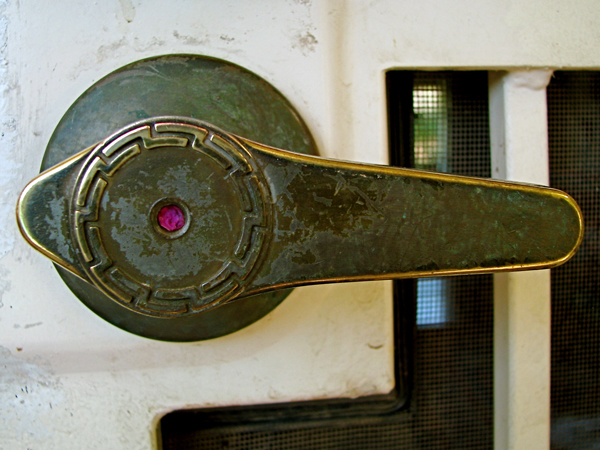Pink eye door
 We have not been stuffing our keyhole with magenta tissue paper.
We have not been stuffing our keyhole with magenta tissue paper.
The local leaf-cutter bees have been trimming neat circles out of fresh, hot pink Bougainvillea bracts and carefully layering them with pollen in a tubular nest for their eggs. The eggs will hatch into grubs — females deepest* so that the woodpecker or cactus wren gets the vulnerable males near the opening (the population needs fewer males to successfully reproduce, the theory goes) — which will eat the pollen and leaf material and hatch into another generation of solitary bees. Solitary bees don’t produce honey, and aren’t at all aggressive, but are vital pollinators in the garden. If you don’t have handy keyholes in your screen doors, you can buy or make nest-boxes with drill holes or bamboo to encourage them. A few scalloped leaves on your bougs or roses is worth it!
Collateral observation: I use this worn lever door-handle fifty times a day, and I never see it close up like in the photo — hadn’t appreciated the “greek key” design circling the hole. Also, I’m pleased to see that its patina is just getting good!
*I couldn’t find out if the gender of the eggs develops as a result of depth, or somehow the female eggs are laid first. The former sounds more plausible to me, but I’d love any ideas?
(For more info, click here . It’s by a British blogger, but the basic lifestyle info is the same for this type of bee on either side of the Atlantic; be sure to enlarge his photos of the cutaway nesting chambers and the circular cuts the bees make on thin, pliable leaves).

That is so very cool!
[…] of soft leaves — three green tubes and one purple. The colors of the tubes depend on the bee’s plant selection. A spare pair of gloves in the garage that no one was using enabled E to get the yardwork done, […]